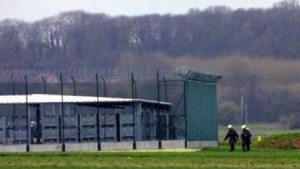At around 1:15 p.m., a fire broke out in a government-owned 3,700 m² historic ammunition depot housing several tons of shells and explosives from the two world wars (discovered and collected by the French mine clearing services). A series of explosions rocked the depot and fire spread to several storage areas. A significant plume of smoke was released, and a neighbouring farmer raised the alarm.
Owing to the risk of incandescent shrapnel, the emergency rescue services established a 1,000-m safety perimeter and let the fire burn without further intervention. Eight people were evacuated from 7 nearby homes and traffic was stopped on 2 roads. Measurements were taken to determine whether or not the smoke was safe. A few explosions were heard the following morning, and intervention on the ground was still impossible. In the evening, a fly-over of the area showed that all the fires had been extinguished. The bomb squad was then able to evacuate and destroy the unstable ammunition (thermally damaged by the fire): 800 kg of ammunition were then neutralised by “blasting” in a nearby field (burial and destruction by an external charge).
The fire brigade was then able to extinguish the remaining wisps of smoke. The site was then cleaned up, and the emergency services were able to leave the site a short while later.
Consequences and actions taken
The fire broke out in the area dedicated to the temporary storage of old ammunition discovered in the ground throughout the region and recovered by bomb disposal technicians from the government’s specialised services during collection campaigns. The area was largely destroyed. All the plastic bins containing ammunition melted under the intense heat. The depot’s concrete slab was damaged by the exploding shells. The metal storage hangars housing the ammunition boxes were damaged (deformed cladding, roof damaged by impacts). Shells and shrapnel thrown during the explosions were found outside the site.
A prefectoral order was issued to suspend operations at the site until it could be thoroughly cleaned up and restored. All storage of explosive products at the site is prohibited.
Causal analysis and measures taken
The causes of the accident remain unknown. The deposit involved was undergoing formalities to rectify its administrative situation.
White phosphorus incendiary bombs were present on the site on the day of the accident. Such bombs have self-igniting properties and may be incompatible with the storage of other types of ammunition.
The site was initially equipped with a sprinkler system but it been taken out of service in 2013. This lack of watering system most likely contributed to the spread of the fire. Given the scale of the incident, intervention by the fire brigade was impossible due to the risk of explosion.
Furthermore, the storage of the bombs outside contributed to the extension of the accident by creating a domino effect.
The site had already undergone extensive renovation work: replacement of fencing and the access gate in 1993, installation of electronic surveillance and reinforcement of intrusion detection devices in 1998, and roofs were installed above the crates of toxic ammunition in 1999. The site was completely reorganised in 2001.
It should also be noted that the site had already experienced several incidents and accidents:
- 2001, after an “imminent danger of explosion” was identified, the Prime Minister decided to evacuate 55 t of ammunition to the Suippes site (Marne) during an operation that required the evacuation of 12,500 people over a one week period and involved many governmental departments (20246);
- 2008: ammunition explosion during an unloading operation, resulting in 2 deaths (19133);
- 2004: fire in a crate of white phosphorus ammunition (28059);
- 2005: explosion of a pallet containing forty-four 77-mm shells (30085).
In response to the findings, the Inspection authorities for classified facilities asked the operator to:
- establish a stock management system (incoming/outgoing log) to know, at any time, the TNT equivalent present on site;
- analyse the feedback associated with white phosphorus ammunition and implement appropriate operating measures;
- limit the storage of ammunition in terms of quantity and duration and suspend the use of plastic bins;
- store ammunition in a closed building with firewalls and no outdoor storage;
- install a video surveillance system (such a system would have made it possible to monitor the progress of the fire);
- raise the height of the bunds;
- submit an application for an operating permit including a complete hazard study;
- study by technical studies: the installation of anti-spatter devices and of an extinguishing and misting system for the ammunition storage , . The separation of storages into independent cells and protection against external aggressions (malicious acts) will also be examined





